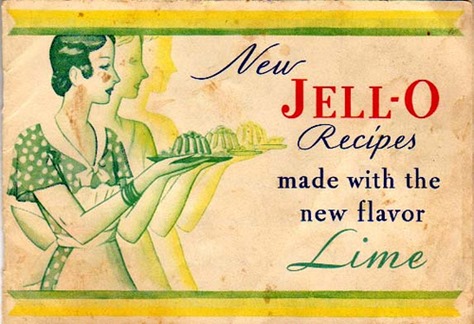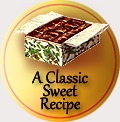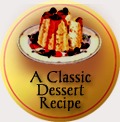
Jell-O is a registered trademark of Kraft Foods for varieties of gelatin desserts, including fruit gels, puddings and no-bake cream pies.
Description
 Jell-O is sold prepared (ready to eat) or in powder form, and is available in various colors and flavors. The powder contains powdered gelatin and flavorings, including sugar or artificial sweeteners. It is dissolved in hot water, then chilled and allowed to set. Fruit, vegetables, and whipped cream can be added to make elaborate snacks that can be molded into shapes. Jell-O must be put in a refrigerator until served, and once set, it can be eaten.
Jell-O is sold prepared (ready to eat) or in powder form, and is available in various colors and flavors. The powder contains powdered gelatin and flavorings, including sugar or artificial sweeteners. It is dissolved in hot water, then chilled and allowed to set. Fruit, vegetables, and whipped cream can be added to make elaborate snacks that can be molded into shapes. Jell-O must be put in a refrigerator until served, and once set, it can be eaten.
There are non-gelatin pudding and pie filling products sold under the Jell-O brand. Pudding is cooked on the stove top with milk, then eaten warm or chilled until firmly set. Jell-O has an instant pudding product which is mixed with cold milk and chilled. To make pie fillings, the same products are prepared with less liquid.
History
Early history
 Gelatin, a protein produced from collagen extracted from boiled bones, connective tissues, and other animal products, has been a component of food, particularly desserts, since the 15th century.
Gelatin, a protein produced from collagen extracted from boiled bones, connective tissues, and other animal products, has been a component of food, particularly desserts, since the 15th century.
Gelatin was popularized in the west in the Victorian era with spectacular and complex “jelly moulds”. Gelatin was sold in sheets and had to be purified, which was time-consuming. Gelatin desserts were the province of royalty and the relatively well-to-do. In 1845, a patent for powdered gelatin was obtained by industrialist Peter Cooper, who built the first American steam-powered locomotive, the Tom Thumb. This powdered gelatin was easy to manufacture and easier to use in cooking.
In 1897, in LeRoy, New York, carpenter and cough syrup manufacturer, Pearle Bixby Wait trademarked a gelatin dessert, called Jell-O. He and his wife May added strawberry, raspberry, orange and lemon flavoring to granulated gelatin and sugar. Then in 1899, Jell-O was sold to Orator Francis Woodward (1856–1906), whose Genesee Pure Food Company produced the successful Grain-O health drink. Part of the legal agreement between Woodward and Wait dealt with the similar Jell-O name.
Going mainstream

Various elements were key to Jell-O becoming a mainstream product: new technologies, such as refrigeration, powdered gelatin and machine packaging, home economics classes, and the company’s marketing.
 Initially Woodward struggled to sell the powdered product. Beginning in 1902, to raise awareness, Woodward’s Genesee Pure Food Company placed advertisements in the Ladies’ Home Journal proclaiming Jell-O to be “America’s Most Famous Dessert.” Jell-O was a minor success until 1904, when Genesee Pure Food Company sent armies of salesmen into the field to distribute free Jell-O cookbooks, a pioneering marketing tactic. Within a decade, three new flavors, chocolate (discontinued in 1927), cherry and peach, were added, and the brand was launched in Canada.[9] Celebrity testimonials and recipes appeared in advertisements featuring actress Ethel Barrymore and opera singer Ernestine Schumann-Heink. Some Jell-O illustrated advertisements were painted by Maxfield Parrish.
Initially Woodward struggled to sell the powdered product. Beginning in 1902, to raise awareness, Woodward’s Genesee Pure Food Company placed advertisements in the Ladies’ Home Journal proclaiming Jell-O to be “America’s Most Famous Dessert.” Jell-O was a minor success until 1904, when Genesee Pure Food Company sent armies of salesmen into the field to distribute free Jell-O cookbooks, a pioneering marketing tactic. Within a decade, three new flavors, chocolate (discontinued in 1927), cherry and peach, were added, and the brand was launched in Canada.[9] Celebrity testimonials and recipes appeared in advertisements featuring actress Ethel Barrymore and opera singer Ernestine Schumann-Heink. Some Jell-O illustrated advertisements were painted by Maxfield Parrish.
In 1923, the newly rechristened Jell-O Company launched D-Zerta, an artificially sweetened version of Jell-O. Two years later, Postum and Genesee merged, and in 1927 Postum acquired Clarence Birdseye’s frozen foods company to form the General Foods Corporation.
 By 1930, there appeared a vogue in American cuisine for congealed salads, and the company introduced lime-flavored Jell-O to complement the add-ins that cooks across the country were combining in these aspics and salads. Popular Jell-O recipes often included ingredients like cabbage, celery, green peppers, and even cooked pasta.
By 1930, there appeared a vogue in American cuisine for congealed salads, and the company introduced lime-flavored Jell-O to complement the add-ins that cooks across the country were combining in these aspics and salads. Popular Jell-O recipes often included ingredients like cabbage, celery, green peppers, and even cooked pasta.
By the 1950s, salads would become so popular that Jell-O responded with savory and vegetable flavors such as celery, Italian, mixed vegetable and seasoned tomato. These flavors have since been discontinued.
In 1934, sponsorship from Jell-O made comedian Jack Benny the dessert’s spokesperson. At this time Post introduced a jingle (“featured” by the agency Young & Rubicam) that would be familiar over several decades, in which the spelling “J-E-L-L-O” was (or could be) sung over a rising five-note musical theme. The jingle was written by Don Bestor, who was the bandleader for Jack Benny on his radio program.
In 1936, chocolate returned to the Jell-O lineup, as an instant pudding made with milk. It proved enormously popular, and over time other pudding flavors were added such as vanilla, tapioca, coconut, pistachio, butterscotch, egg custard, flan and rice pudding.
Baby boom
The baby boom saw a significant increase in sales for Jell-O. Young mothers didn’t have the supporting community structures of earlier generations, so marketers were quick to promote easy-to-prepare prepackaged foods. By this time, creating a Jell-O dessert required simply boiling water, Jell-O and Tupperware molds.

New flavors were continually added and unsuccessful flavors were removed: in the 1950s and 1960s, apple, black cherry, black raspberry, grape, lemon-lime, mixed fruit, orange-banana, pineapple-grapefruit, blackberry, strawberry-banana, tropical fruit and more intense “wild” versions of the venerable strawberry, raspberry and cherry. In 1966, the Jell-O “No-Bake” dessert line was launched, which allowed a cheesecake to be made in 15 minutes. In 1969, Jell-O 1∗2∗3 (later Jell-O 1•2•3), a gelatin dessert that separated into three layers as it cooled, was unveiled. Until 1987, Jell-O 1•2•3 was readily found in grocery stores throughout most of the United States, but the dessert is now rare. In 1971 packaged prepared pudding called Jell-O Pudding Treats were introduced. Jell-O Whip ‘n Chill, a mousse-style dessert, was introduced and widely promoted; it remains available in limited areas today.
Sales decline and turnaround
 In 1964, the slogan “There’s always room for Jell-O” was introduced, promoting the product as a “light dessert” that could easily be consumed even after a heavy meal.
In 1964, the slogan “There’s always room for Jell-O” was introduced, promoting the product as a “light dessert” that could easily be consumed even after a heavy meal.
Throughout the 1960s through the 1980s, Jell-O’s sales steadily decreased. Many Jell-O dishes, such as desserts and Jell-O salads, became special occasion foods rather than everyday items. Marketers blamed this decline on decreasing family sizes, a “fast-paced” lifestyle and women’s increasing employment. By 1986, a market study concluded that mothers with young children rarely purchased Jell-O.
To turn things around, Jell-O hired Dana Gioia to stop the decline. The marketing team revisited the Jell-O recipes published in past cookbooks and rediscovered Jigglers, although the original recipe did not use that name. Jigglers are Jell-O snacks molded into fun shapes and eaten as finger food. Jell-O launched a massive marketing campaign, notably featuring Bill Cosby as spokesman. The campaign was a huge success, causing a significant gain.
 Cosby became the company’s pudding spokesperson in 1974, and continued as the voice of Jell-O for almost thirty years. Over his tenure as the mouthpiece for the company, he would help introduce new products such as frozen Jell-O Pops (in gelatin and pudding varieties); the new Sugar-Free Jell-O, which replaced D-Zerta in 1984 and was sweetened with NutraSweet; Jell-O Jigglers concentrated gummi snacks; and Sparkling Jell-O, a carbonated version of the dessert touted as the “Champagne of Jell-O.” In 2010, Cosby returned as Jell-O spokesperson in an on-line web series called “OBKB.”
Cosby became the company’s pudding spokesperson in 1974, and continued as the voice of Jell-O for almost thirty years. Over his tenure as the mouthpiece for the company, he would help introduce new products such as frozen Jell-O Pops (in gelatin and pudding varieties); the new Sugar-Free Jell-O, which replaced D-Zerta in 1984 and was sweetened with NutraSweet; Jell-O Jigglers concentrated gummi snacks; and Sparkling Jell-O, a carbonated version of the dessert touted as the “Champagne of Jell-O.” In 2010, Cosby returned as Jell-O spokesperson in an on-line web series called “OBKB.”
In the 1980s, a Jell-O advertising campaign slogan reminded consumers, “Don’t forget—you have to remember to make it.”
 In 1990, General Foods merged into Kraft Foods by parent company Philip Morris (now the Altria Group). New flavors were continually introduced: watermelon, blueberry, cranberry, margarita and piña colada among others. In 2001, the state Senate of Utah recognized Jell-O as a favorite snack food of Utah and the Governor Michael O. Leavitt declared an annual “Jell-O Week.” During the 2002 Winter Olympics in Salt Lake City, the souvenir pins included one depicting green Jell-O.
In 1990, General Foods merged into Kraft Foods by parent company Philip Morris (now the Altria Group). New flavors were continually introduced: watermelon, blueberry, cranberry, margarita and piña colada among others. In 2001, the state Senate of Utah recognized Jell-O as a favorite snack food of Utah and the Governor Michael O. Leavitt declared an annual “Jell-O Week.” During the 2002 Winter Olympics in Salt Lake City, the souvenir pins included one depicting green Jell-O.
In the late 1980s and early 1990s, Jell-O’s family-friendly reputation was slightly tarnished by Jell-O shots and Jell-O wrestling.
As of 2008, there are more than 158 products sold under the Jell-O brand name with 300 million boxes of Jell-O gelatin sold in the United States each year.

Jell-O is used as a substantial ingredient in a well-known dessert, a “Jell-O mold” the preparation of which requires a mold designed to hold gelatin, and the depositing of small quantities of chopped fruit, nuts, and other ingredients before it hardens to its typical form. Fresh pineapple, papaya, kiwi, and ginger root cannot be used because they contain enzymes that prevent gelatin from “setting”. In the case of pineapple juice and the enzyme bromelain that it contains though, the enzyme can be inactivated without denaturing through excessive heating and thus altering the flavor by the addition of a small measured amount of capsaicin sourced from hot chilies.
 Jelly beans are small bean-shaped sugar candies with soft candy shells and thick gel interiors. The confection comes in a wide variety of colors and flavors, and is primarily made of sugar.
Jelly beans are small bean-shaped sugar candies with soft candy shells and thick gel interiors. The confection comes in a wide variety of colors and flavors, and is primarily made of sugar. It is generally thought that jelly beans first surfaced in 1861, when Boston confectioner William Schrafft urged people to send his jelly beans to soldiers during the American Civil War. It was not until July 5, 1905, that jelly beans were mentioned in the Chicago Daily News. The advertisement publicized bulk jelly beans sold by volume for nine cents per pound, according to the book The Century in Food: America’s Fads and Favorites. Today, most historians contend that jelly beans were first linked with celebrations of Easter in the United States sometime in the 1930s for their egg-like shape.
It is generally thought that jelly beans first surfaced in 1861, when Boston confectioner William Schrafft urged people to send his jelly beans to soldiers during the American Civil War. It was not until July 5, 1905, that jelly beans were mentioned in the Chicago Daily News. The advertisement publicized bulk jelly beans sold by volume for nine cents per pound, according to the book The Century in Food: America’s Fads and Favorites. Today, most historians contend that jelly beans were first linked with celebrations of Easter in the United States sometime in the 1930s for their egg-like shape. The basic ingredients of jelly beans include sugar, corn syrup, and pectin or starch. Relatively minor amounts of the emulsifying agent lecithin, anti-foaming agents, an edible wax such as beeswax, salt, and confectioner’s glaze are also included. The ingredients that give each bean its character are also relatively small in proportion and may vary depending on the flavor.
The basic ingredients of jelly beans include sugar, corn syrup, and pectin or starch. Relatively minor amounts of the emulsifying agent lecithin, anti-foaming agents, an edible wax such as beeswax, salt, and confectioner’s glaze are also included. The ingredients that give each bean its character are also relatively small in proportion and may vary depending on the flavor. Some premium brands, such as Jelly Belly and The Jelly Bean Factory, are available in many different flavors, including berry, tropical fruit, soft drink, popcorn, licorice, and novelty ranges, in addition to the familiar fruit and spice flavors. While these are also sold as assortments, individual flavors can be individually purchased from distributors. A version of the Bertie Botts Every Flavor Beans from the Harry Potter series was made commercially available and included flavors described as earwax, dirt, pepper, and vomit.
Some premium brands, such as Jelly Belly and The Jelly Bean Factory, are available in many different flavors, including berry, tropical fruit, soft drink, popcorn, licorice, and novelty ranges, in addition to the familiar fruit and spice flavors. While these are also sold as assortments, individual flavors can be individually purchased from distributors. A version of the Bertie Botts Every Flavor Beans from the Harry Potter series was made commercially available and included flavors described as earwax, dirt, pepper, and vomit. In United States slang in the 1910s and early 1920s, a “Jellybean” or “Jelly-Bean” was a young man who dressed stylishly to attract women but had little else to recommend him, similar to the older terms dandy and fop and the slightly later drugstore cowboy. F. Scott Fitzgerald wrote a story about such a character, The Jelly-Bean, in 1920. In William Faulkner’s 1929 novel The Sound and the Fury, Jason complained bitterly about his niece Quentin’s promiscuity, remarking that even “the town jellybeans” gave her the “go-by”.
In United States slang in the 1910s and early 1920s, a “Jellybean” or “Jelly-Bean” was a young man who dressed stylishly to attract women but had little else to recommend him, similar to the older terms dandy and fop and the slightly later drugstore cowboy. F. Scott Fitzgerald wrote a story about such a character, The Jelly-Bean, in 1920. In William Faulkner’s 1929 novel The Sound and the Fury, Jason complained bitterly about his niece Quentin’s promiscuity, remarking that even “the town jellybeans” gave her the “go-by”.

































